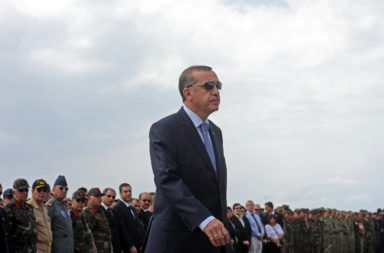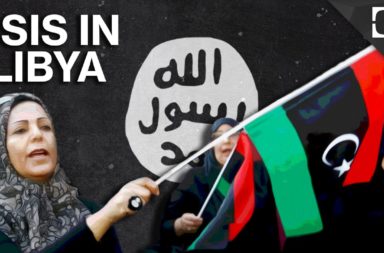The United States seems to be succeeding in putting more and more pressure on ISIS. Although it is far from clear when ISIS will be defeated in either Syria or Iraq, the combination of anti-ISIS forces in each country now seems likely to inflict a series of steady defeats, and ISIS may lose control of a number of major population centers at some point between the end of the year and mid-2017.
Any such victory, however, depends on the various anti-ISIS factions in Syria and Iraq avoiding deeper conflict among themselves. Victory also will be limited even in terms of the defeat of ISIS. Many ISIS fighters will escape. ISIS already has cells and affiliates in other countries. And—just as Al Qa’ida in Mesopotamia transformed itself into ISIS—there will still be movements committed to equally violent forms of Islamist extremism such as the Al Nusra Front. The “war against terrorism” will go on, perhaps focusing even more on outside states, while the vengeful fighters will disperse to other countries.
Iraq: Defeating ISIS, Empowering Iran, Alienating Sunni and Shi’ite Arabs, and Isolating the Kurds?
The United States, however, will face much broader problems. Defeating ISIS in Iraq has so far shown no signs of weakening Iranian influence. If anything, Iran seems to be able to take advantage of its own presence on the ground, and its ties to Shi’ite militias to take credit wherever possible, while downplaying the role of the U.S.-led air coalition and the U.S. train and assist mission on the ground.
The Iraqi central government is as divided as ever, and its assembly is more dominated by competing sectarian and ethnic factions, than by support for Prime Minister Haider al-Abadi or reform. Cuts in oil export revenues have left the Iraqi government effectively bankrupt, corruption is endemic, and no real healing has taken place in the relations between Sunni and Shi’ite. The facts on the ground around Fallujah are far from clear, but Iraq is filled with rumors of new abuses of many Sunnis fleeing the city perpetrated by the Shi’ite militias who surround it. The flow of supplies and reinforcements to central government forces seems uncertain at best, as seem its efforts to help civilians caught up in the fighting.
Sunni militias remain weak and poorly supported, and tensions between Sunni and Shi’ite seem to be steadily rising on a national level. U.S. encouragement of sectarian unity, reform and effective governance exists, but seems to be limited largely to exhortation and have little real impact. The United States faces a good chance—if not probability—that its efforts to defeat ISIS in Iraq will end in empowering an Iranian influenced Shi’ite-dominated government, while showing Sunnis inside and outside Iraq that once again the United States could not help Iraqi Sunnis on any lasting basis.
U.S. ties to Iraqi Kurdish fighters bring it closer to a Kurdistan Regional Government (KRG) that is as divided and corrupt as the Iraqi central government. The divisions and uncertain alliances between the Patriotic Union of Kurdistan (PUK), the Gorran or Change Movement, and the Kurdistan Democratic Party (KDP) shows that an old Middle East saying—“the Kurds have no friends but the mountains”—should really be phrased as “the Kurds have no friends, including the Kurds.” At the same time, the cut in petroleum revenues have made the struggle over oil exports between the Iraqi Kurds and central government even more difficult, and left the Iraqi Kurds with just as much of a financial crisis.
The U.S. military support of the Iraqi Kurds, and their victories against ISIS have also given the Iraqi Kurds about 40% more territory than they previously occupied before ISIS invaded—including Kirkuk and key northern oil and gas fields. These are substantial areas that were not “Kurdish” before the United States created a security zone in Northern Iraq, and then invaded in 2003.
This will present serious problems during any “liberation” of Mosul, as well as after ISIS is defeated. Arabs on all sides will see the United States as having empowered the Kurds—while the Iraqi Kurds will have to deal with both the Arabs, and with unpredictable relations with Turkey and Iran.
This adds to the strategic challenges that the United States faces in Iraq, because at some point the U.S. will have to choose its post-ISIS conflict alignments in Iraq, and may have to do so with Abadi gone, Ali al-Sistani dead, and new power struggles by Muqtada al-Sadr and other more polarizing figures. Russia also has the potential option of offering to at least partially replace the United States as a source of arms and advisors in the region—particularly if Russia chooses to continue to sell Iran advanced arms like the S300.
Syria: Defeating ISIS, Empowering Assad, Russia, Iran, Alienating Sunni and Shi’ite Arabs as Well as Turkey, and Leaving the Syrian Kurds Caught Between Them?
The situation in Syria is somewhat similar to the situation in Iraq, but the lack of an effective U.S. strategy may well have even worse consequences in Syria. The creeping pace of incremental U.S. military action may again help trigger the defeat of ISIS in Syria. It also, however, has probably played a critical part in the steadily rising human cost of the broader Syrian Civil War. Bad as ISIS is, the vast majority of civilian casualties and economic damage has come from the ruthless violence of the Assad regime and its supporters.
There is no way to be precise, but various estimates now put the number of conflict-related deaths at the following levels, with estimates at 400,000 or above now seeming likely to be more accurate:
| · Syrian Centre for Policy Research | · 470,000 killed |
| · UN and Arab League Envoy to Syria | · 400,000 killed |
| · Center for Documentation of Violations | · 155,587 killed |
| · Syrian Observatory for Human Rights | · 282,283–402,819 killed |
The UNHCR web page estimates that more than 4.8 million people had fled Syria as of March 2016, and that 8.7 million more people were internally displaced persons (IDPs), who had lost their home, job or business. For all of the media focus on Europe’s refugee problem, Syrian refugees alone included 2.1 million Syrians registered by UNHCR in Egypt, Iraq, Jordan and Lebanon, 2.7 million Syrians registered by the Government of Turkey, as well as more than 29,000 Syrian refugees registered in North Africa. Only about 10 percent (494,000) were in camps, and the UN had received less than $1 billion (22 percent) out of an aid requirement of $4.6 billion as of May 2016.
This compares to an estimate in the CIA World Factbook that Syria’s total population was around 17.1 million as of July 2014, and that the economy had declined by 62 percent from a GDP of $97.5 billion in 2010 to $55.8 billion in 2014. It is impossible to accurately estimate the impact on ordinary Syrians, but one key reason for the uprisings in Syria that began in 2011 was that the Assad regime had turned Syria into a failed state in economic terms, and that it had an extremely low per capita income of only $5,200. That per capita income seems likely to be under $2,000 today, and it is all too clear that much of it is distributed in ways that go to Assad, his supporters and warlords, and a limited number of Sunni supporters and cronies.
No one can accurately estimate how much worse things have gotten since 2014, but two things are clear: First, state terrorism by the Assad regime has caused the vast majority of this suffering—not the actions of ISIS. Second, the failure by the United States to act decisively early in the conflict may well have raised the resulting butcher’s bill to catastrophic levels.
The practical problems for American strategy in Syria begin with the fact that Syria faces even more critical challenges in going from the fight against ISIS to any form of stability, recovery, and development than does Iraq. Syria is the scene of an active civil war where Russian intervention in the partial power vacuum created by the United States has not only allowed the Assad regime to survive, but has given it real hope of controlling most of the population, and possibly defeating relatively weak and divided Arab rebels.
The United States still has yet to show that it can create any meaningful U.S.-supported Arab rebel force. So far, its support of such rebels has largely had the effect of helping to arm the Al Nusra Front (an al Qai’da affiliate) in Northwest Syria, and making Jordan a target for supporting different U.S. efforts in southeastern Syria. The United States has failed to show that it can work effectively with Arab states like the UAE and Saudi Arabia to create broader efforts to create effective and moderate Arab forces. U.S. diplomacy seems to have done more to empower Russia, Assad, Hezbollah, and Iran than bring an end to the conflict. Even if the U.S. effort succeeded, it is unclear whether it would not leave most of Syria under some form of Assad regime backed by Iran and Russia.
Once again, the United States has created a major Kurdish problem in Syria without demonstrating it has any clear solution. The United States may have failed in dealing with the Arab rebels—who now are so divided that the Free Syrian Army (FSA) seems to have more than 40 groups, and non-FSA groups (including violent Islamist extremist groups like the Al Nusra Front, Ahrar ash-Sham, Jaysh al-Islam,Ansar al-Sham, and Abina al-Sham) number some 15 more.
The United States has been far more successful, however, in dealing with the Syrian Kurds—which are now, by far the dominant force in the Federation of Northern Syria. The Kurdish People’s Protection Units (YPG)—which are tied to the Syrian Kurdish Democratic Union Party (PYD)—have been so successful against ISIS that they have received massive U.S. backing, and have been able to take control over most of the northern border area in Syria next to Turkey.
Once again, this is Kurdish expansion at the expense of the Arabs, with no clear prospects as a viable state, and no clear plan for any kind of federal role. It also raises the problem that the YPG has been tied to elements of the Kurdistan Worker’s Party (PKK), which Turkey has gone back to actively fighting and regards as a terrorist movement—leading it to treat the YPG as hostile, and label it as a terrorist movement. Moreover, Turkey is also fighting PKK elements in Iraq, and fears an alliance between Iraqi and Syrian Kurds with Turkish Kurds. As a result, the United States is backing a Kurdish force that not only presents problems in dealing with Arabs, but major problems in dealing with Turkey as well.
The Need for a Clear Strategy and End Game
The United States cannot serve its own interests or those of any regional ally—including Israel and other Arab states—simply by focusing on ISIS. Yet, to put it simply and starkly, the Obama Administration has not offered any convincing strategy to deal with any of these issues. It does not seem to see the broader fight in Syria and Iraq as the real key to any form of grand strategic success, it does not have a clear civil dimension to its operations in either country, and it does not have any apparent plan or cohesive approach to dealing with the aftermath of defeating ISIS as a proto-state.
This is not to say that there are any simple or “good” options for dealing with a far more complicated and serious set of problems than one terrorist threat. However, this is no excuse for not choosing the best options that actually are available to implement some form of broader grand strategy. It is also striking that even as the United States’ ability to help local forces defeat ISIS improves, the end result is to some extent a power vacuum that Iran, Russia, and hostile Iraqi and Syrian political forces may come to fill. The end result may be an even worse form of tactical “victory” than the Bush Administration left the Obama Administration. It may pass on a poison cup as it leaves office, but it will scarcely be a chalice.




